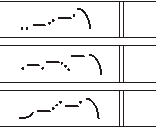
CATEGORIES:
BiologyChemistryConstructionCultureEcologyEconomyElectronicsFinanceGeographyHistoryInformaticsLawMathematicsMechanicsMedicineOtherPedagogyPhilosophyPhysicsPolicyPsychologySociologySportTourism
Graphical Representation of Intonation and Basic Notions
The information conveyed by a sentence is expressed not only by its lexical and grammatical structure but also by intonation.
The term Ďintonationí implies:
1) variations in pitch;
2) utterance stress;
3) tempo;
4) rhythm;
5) pausation;
6) timbre.
Intonation may be shown in the line of text and on the scales (staves).
a) To mark the intonation in the line of text we use Roger Kingdonís stress-mark system, which consists of vertical stress marks to indicate stressed syllables and slant marks (\ /) above and below the line of print to show the final tones.
b) We use Lily Armstrongís system of dots for unstressed syllables, dashes for stressed syllables and slant marks (curves) for final tones to indicate intonation on the scales. A downward curve represents the final fall and an upward curve represents the final rise.
Each tone group has its own pitch-and-stress pattern. Generally three pitch levels are distinguished: low, medium, high.

The pitch range is the interval between two pitch levels. Pitch ranges may be normal, wide and narrow.
We distinguish certain elements in the pitch-and-stress pattern of every intonation group.

A pre-head. It is initial unstressed syllables. It may be low and high. A low pre-head consists of unstressed syllables pronounced at a low pitch. It is used frequently and considered neutral. A high pre-head is pronounced at a high pitch and makes the utterance sound emotional.
A head. It is the first stressed syllable in the utterance. It may be low and high. A low head introduces ascending scale and a high head introduces descending scale.
A scale. It is a series of stressed and unstressed syllables beginning with the first stressed syllable up to the last stressed syllable.
Scales may be a) according to their general pitch direction level, descending (the stressed syllables are gradually descending) and ascending (the stressed syllables are gradually ascending);
b) according to the direction of pitch movement within and between syllables descending scales may be falling, stepping, gliding (sliding) and scandent.
Study the diagram.
 1. falling scale
1. falling scale
2. stepping scale
3. gliding (sliding) scale
4. scandent scale
 Look at the examples:
Look at the examples:
1. Falling scale:
The  year is di'vided into 'four
year is di'vided into 'four  seasons.
seasons.
2. Stepping scale:
 Pity 'Peter 'couldnít
Pity 'Peter 'couldnít  come.
come.

3. Sliding (gliding) scale.
 Donít 'speak 'too
Donít 'speak 'too  soon.
soon.
4. Scandent scale.
 What a 'pretty 'little
What a 'pretty 'little  house.
house.
Ascending scales may be stepping, sliding and scandent.
Study the diagram.
 1. stepping scale
1. stepping scale
2. sliding scale
3. scandent scale
Look at the examples:
 1. Stepping scale.
1. Stepping scale.
I could  hardly be'lieve my
hardly be'lieve my  eyes.
eyes.
2. Sliding scale.
Itís  such a 'pity that you 'canít
such a 'pity that you 'canít  come.
come.
3. Scandent scale.
 Why 'havenít you ar'rived in
Why 'havenít you ar'rived in  time?
time?
Level scales may be high, mid, low.
Study the diagram.

Look at the example:
 High level scale.
High level scale.
 What 'fine
What 'fine  weather !
weather !
Descending scales. Utterances pronounced with the descending scale express interest, they sound friendly. The descending scale is the commonest scale used with all the English tones.
 Look at the example :
Look at the example :
 How do you pro'nounce this
How do you pro'nounce this  word ?
word ?
The ascending scale is regarded as a feature of emotional speech. It is used in many cases to express a negative attitude, irritation, indignation and anger. It is also used to express surprise, interest, protest.
 Look at the examples:
Look at the examples:
 Donít 'stand by 'that
Donít 'stand by 'that  window .
window .
I could  hardly be'lieve my
hardly be'lieve my  eyes .
eyes .
 Why 'havenít you ar'rived in
Why 'havenít you ar'rived in  time .
time .
The nucleus. It is the last stressed syllable in the pattern pronounced with a tone. At present we operate with nine tones in the system of OíConnor and Arnold.
Study the diagram.

L-F H-F R-F L-R H-R F-R
All falling tones sound complete, categoric, laconic. Rise-Fall makes the utterance rather expressive. It exists in a kind of mocking or envious remarks. High Fall expresses liveliness, polite and friendly interest, personal involvement and sometimes mild surprise. Rising tones sound non-final and incomplete. Something is left unsaid. These tones mean continuation. The Low Rise is used in ordinary speech. The Low Rise and Fall Rise are synonymous, but Fall Rise is more emotional and it shows contrast and contradiction.
 Look at the examples:
Look at the examples:
As  far as I
far as I  know
know
As far as I  know
know
The High Rise is used in echoing questions.
 What ?
What ?
Level tones are presented by Low Level, Mid Level and High Level tones.
Date: 2015-12-24; view: 4867
| <== previous page | | | next page ==> |
| The Reduction of Consonants Clusters | | | How to Use the Tunes |